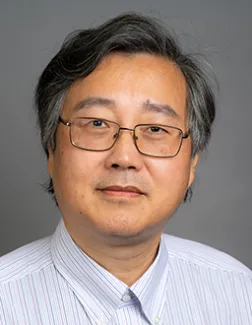

Research Overview
Guangwei Zhou's research focuses on evoked potential and vestibular studies. Currently, he is studying hearing losses attributable to inner-ear anomalies, such as enlarged vestibular aqueduct (EVA) and semicircular canal dehiscence (SCD).
He is also investigating the effects of cochlear implant(s) on vestibular/balance function in children. His study on correlation of hearing loss and vestibular deficits in children with congenital/genetic hearing loss is ongoing. Dr. Zhou's previous research focused on Vestibular Evoked Myogenic Potential (VEMP) testing and its clinical applications, especially in diagnosing Ménière's disease and superior canal dehiscence.
Research Background
Guangwei Zhou received his Master of Science in 2000 and Doctor of Science in Audiology in 2003 from Sargent College at Boston University. He completed his Audiology Clinical Fellowship at Massachusetts Eye and Ear Infirmary in 1999-2000. He also has a medical degree from Beijing Medical University.
His medical trainings include residency in Otolaryngology-Head and Neck Surgery at the Third Hospital of Beijing Medical University in 1990-1994 and post-doctoral research fellowship in the Department of Otology and Laryngology at Harvard Medical School in 1995-1996.
Education
Undergraduate School
Medical School
Publications
- Dysfunction of vestibulo-ocular reflex in infants and toddlers. Int J Pediatr Otorhinolaryngol. 2025 Mar; 190:112247. View Abstract
- Evidence of vestibular dysfunction in children with enlarged vestibular aqueduct. Int J Pediatr Otorhinolaryngol. 2023 Jun; 169:111574. View Abstract
- Benign Paroxysmal Positional Vertigo in Children and Adolescents With Concussion. Sports Health. 2021 Jul-Aug; 13(4):380-386. View Abstract
- Multifactorial Characteristics of Pediatric Dizziness and Imbalance. Laryngoscope. 2021 04; 131(4):E1308-E1314. View Abstract
- Severe motion sickness in infants and children. Eur J Paediatr Neurol. 2020 Sep; 28:176-179. View Abstract
- Evolution of Cochlear implant mapping and vestibular function in a pediatric case of Labyrinthitis. J Otolaryngol Head Neck Surg. 2020 Feb 05; 49(1):7. View Abstract
- Clinical significance of spontaneous nystagmus in pediatric patients. Int J Pediatr Otorhinolaryngol. 2018 Aug; 111:103-107. View Abstract
- Range of Peak Head Velocity in Video Head Impulse Testing for Pediatric Patients. Otol Neurotol. 2018 06; 39(5):e357-e361. View Abstract
- Peripheral Vestibular Disorders in Children and Adolescents with Concussion. Otolaryngol Head Neck Surg. 2018 08; 159(2):365-370. View Abstract
- Benign paroxysmal migraine variants of infancy and childhood: Transitions and clinical features. Eur J Paediatr Neurol. 2018 Jul; 22(4):667-673. View Abstract
- Benign Paroxysmal Positional Vertigo (BPPV) in Children and Adolescents: Clinical Features and Response to Therapy in 110 Pediatric Patients. Otol Neurotol. 2018 03; 39(3):344-350. View Abstract
- Perioperative Hearing Evaluations for Patients Undergoing Tympanostomy Tube Placement. JAMA Otolaryngol Head Neck Surg. 2016 11 01; 142(11):1070-1074. View Abstract
- Vestibular neuritis in children and adolescents: Clinical features and recovery. Int J Pediatr Otorhinolaryngol. 2016 Apr; 83:104-8. View Abstract
- Evaluation and management of vestibular migraine in children: Experience from a pediatric vestibular clinic. Eur J Paediatr Neurol. 2016 Jan; 20(1):85-92. View Abstract
- Peripheral vestibular loss detected in pediatric patients using a smartphone-based test of the subjective visual vertical. Int J Pediatr Otorhinolaryngol. 2015 Dec; 79(12):2094-8. View Abstract
- Video head impulse testing (VHIT) in the pediatric population. Int J Pediatr Otorhinolaryngol. 2015 Aug; 79(8):1283-7. View Abstract
- Subjective visual vertical testing in children and adolescents. Laryngoscope. 2016 Mar; 126(3):727-31. View Abstract
- Objective vestibular testing of children with dizziness and balance complaints following sports-related concussions. Otolaryngol Head Neck Surg. 2015 Jun; 152(6):1133-9. View Abstract
- Vestibular evoked myogenic potential testing for the diagnosis of conductive hearing loss: survey of pediatric otolaryngologists' knowledge and beliefs. Int J Pediatr Otorhinolaryngol. 2014 Nov; 78(11):1937-9. View Abstract
- Clinical uses of cervical vestibular-evoked myogenic potential testing in pediatric patients. Medicine (Baltimore). 2014 Jun; 93(4):e37. View Abstract
- Clinical use of vestibular evoked myogenic potentials in the evaluation of patients with air-bone gaps. Otol Neurotol. 2012 Oct; 33(8):1368-74. View Abstract
- Characteristics of vestibular evoked myogenic potentials in children with enlarged vestibular aqueduct. Laryngoscope. 2011 Jan; 121(1):220-5. View Abstract
- Inner ear anomalies and conductive hearing loss in children with Apert syndrome: an overlooked otologic aspect. Otol Neurotol. 2009 Feb; 30(2):184-9. View Abstract
- Multiple semicircular canals with dehiscence. Otol Neurotol. 2009 Feb; 30(2):241-2. View Abstract
- Assessment of saccular function in children with sensorineural hearing loss. Arch Otolaryngol Head Neck Surg. 2009 Jan; 135(1):40-4. View Abstract
- Delineating the hearing loss in children with enlarged vestibular aqueduct. Laryngoscope. 2008 Nov; 118(11):2062-6. View Abstract
- Clinical and Diagnostic Characterization of Canal Dehiscence Syndrome: A Great Otologic Mimicker. Otol Neurotol. 2007 Oct; 28(7):920-926. View Abstract
- Clinical and diagnostic characterization of canal dehiscence syndrome: a great otologic mimicker. Otol Neurotol. 2007 Oct; 28(7):920-6. View Abstract
- Superior semicircular canal dehiscence in a young child: implication of developmental defect. Int J Pediatr Otorhinolaryngol. 2007 Dec; 71(12):1925-8. View Abstract
- Vestibular evoked myogenic potentials (VEMP) can detect asymptomatic saccular hydrops. Laryngoscope. 2006 Jun; 116(6):987-92. View Abstract
- Vestibular evoked myogenic potential (VEMP) in patients with Ménière's disease with drop attacks. Laryngoscope. 2006 May; 116(5):776-9. View Abstract
- Vestibular evoked myogenic potentials: history and overview. Am J Audiol. 2004 Dec; 13(2):135-43. View Abstract
- Vestibular evoked myogenic potentials versus vestibular test battery in patients with Meniere's disease. Otol Neurotol. 2004 Nov; 25(6):981-6. View Abstract
- Vestibular evoked myogenic potentials show altered tuning in patients with Ménière's disease. Otol Neurotol. 2004 May; 25(3):333-8. View Abstract